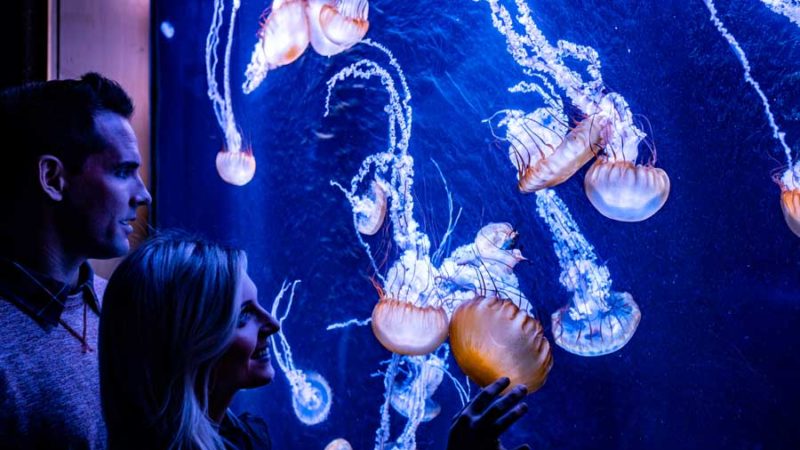Jellyfish at Wonders of Wildlife

Published October 23, 2018
Did you know that jellyfish aren’t really fish? They are actually invertebrates (a creature that lacks a backbone) because they don’t have a bone structure like a fish would. Because of this, they are sometimes referred to as “jellies” rather than “jellyfish.” A jelly is made up of about 95 percent water. They lack a skeleton, a brain, a head, blood, a heart, organs for respiring, and organs for excreting waste. Instead, jellies are made of three different layers (epidermis, mesoglea, and gastrodermis), a nervous system, and a digestive cavity. Their nervous system gives them the ability to sense light, smell, and respond to stimuli.
Movement
Jellies use one singular muscle to move in their well-known pulsing manner. They contract and relax this muscle, which allows them to propel short distances. Jellyfish move by pulling the water from above them into their bell, thus creating suction. This water is then pushed out, or released, below them. The renowned “pulsing†movement of jellyfish is due to their pulling forward through water rather than pushing water. In addition to using this pulling movement, jellies also drift with water currents.
Venom
The sting felt from a jelly is due to the shooting of venom from nematocysts. Nematocysts are structures containing venom. These structures are found within specialized cells along jelly tentacles. Typically, this release of venom is caused by physical contact with the jelly. The venom is used by jellyfish to paralyze their prey before digesting it.
Jellies at Wonders of Wildlife
There are more than 2,000 known jelly species with many more likely waiting to be discovered. When you visit Wonders of Wildlife, some of the jelly species you might see include moon jellies, blue blubber jellies, or west coast sea nettles. The primary diet of the jellies at WOW include brine shrimp or sea monkeys that the aquarium hatches in-house.

Moon jellies will show different coloring based on their diet. Pink moon jellies eat primarily crustaceans, while orange moon jellies eat primarily brine shrimp.

Blue blubber jellies are eaten by people throughout Asia. These jellies don’t have a central mouth or tentacles; instead, their arms are covered in many small mouths.

West coast sea nettles can be found along the west coast of the United States and are medusivores, meaning they will eat other jellyfish.
News & Updates
Read the latest news & updates about Wonders of Wildlife.
